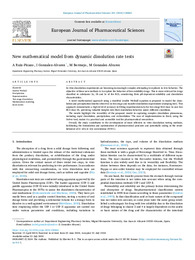Por favor, use este identificador para citar o enlazar este ítem:
https://hdl.handle.net/11000/35161Registro completo de metadatos
| Campo DC | Valor | Lengua/Idioma |
|---|---|---|
| dc.contributor.author | Ruiz Picazo, Alejandro | - |
| dc.contributor.author | Gonzalez-Alvarez, I | - |
| dc.contributor.author | Bermejo, M | - |
| dc.contributor.author | Gonzalez-Alvarez, M | - |
| dc.contributor.other | Departamentos de la UMH::Ingeniería | es_ES |
| dc.date.accessioned | 2025-01-22T12:16:50Z | - |
| dc.date.available | 2025-01-22T12:16:50Z | - |
| dc.date.created | 2024-07 | - |
| dc.identifier.citation | European Journal of Pharmaceutical Sciences 201 (2024) 106864 | es_ES |
| dc.identifier.issn | 0928-0987 | - |
| dc.identifier.uri | https://hdl.handle.net/11000/35161 | - |
| dc.description.abstract | In vitro dissolution experiments are becoming increasingly complex attempting to replicate in vivo behavior. The objective of these new methods is to explore the behavior of low-solubility drugs. This is more relevant for drugs classified in subclasses 2a, 2b and 2c of the BCS, considering their pH-dependent solubility and dissolution characteristics. A novel mathematical approach using a modified double Weibull equation is proposed to model the dissolution and precipitation kinetics observed in two-stage and transfer dissolution experiments (dumping test). This approach demonstrates a high level of accuracy in fitting experimental data for two drugs BCS class 2a and two BCS class 2b, providing valuable insights into their dissolution behavior under different conditions. The results highlight the versatility of the proposed model in capturing complex dissolution phenomena, including rapid dissolution, precipitation, and redissolution. The ease of implementation in Excel, using the Solver tool, makes it a practical and accessible tool for pharmaceutical researchers. Overall, the study contributes to the development of more effective in vitro dissolution testing methods, facilitating the formulation and optimization of pharmaceutical products and potentially aiding in the establishment of in vitro-in vivo correlations (IVIVC) | es_ES |
| dc.format | application/pdf | es_ES |
| dc.format.extent | 10 | es_ES |
| dc.language.iso | eng | es_ES |
| dc.publisher | Elsevier | es_ES |
| dc.rights | info:eu-repo/semantics/openAccess | es_ES |
| dc.rights | Attribution-NonCommercial-NoDerivatives 4.0 Internacional | * |
| dc.rights.uri | http://creativecommons.org/licenses/by-nc-nd/4.0/ | * |
| dc.subject | Double Weibull | es_ES |
| dc.subject | Precipitation | es_ES |
| dc.subject | Supersaturation | es_ES |
| dc.subject | Two-stage dissolution | es_ES |
| dc.subject | Mathematical modeling | es_ES |
| dc.subject | Excel solver | es_ES |
| dc.subject.other | CDU::6 - Ciencias aplicadas::62 - Ingeniería. Tecnología | es_ES |
| dc.title | New mathematical model from dynamic dissolution rate tests | es_ES |
| dc.type | info:eu-repo/semantics/article | es_ES |
| dc.relation.publisherversion | https://doi.org/10.1016/j.ejps.2024.106864 | es_ES |

Ver/Abrir:
1 New mathematical model from dynamic dissolution rate tests (1).pdf
2,49 MB
Adobe PDF
Compartir:
 La licencia se describe como: Atribución-NonComercial-NoDerivada 4.0 Internacional.
La licencia se describe como: Atribución-NonComercial-NoDerivada 4.0 Internacional.
.png)